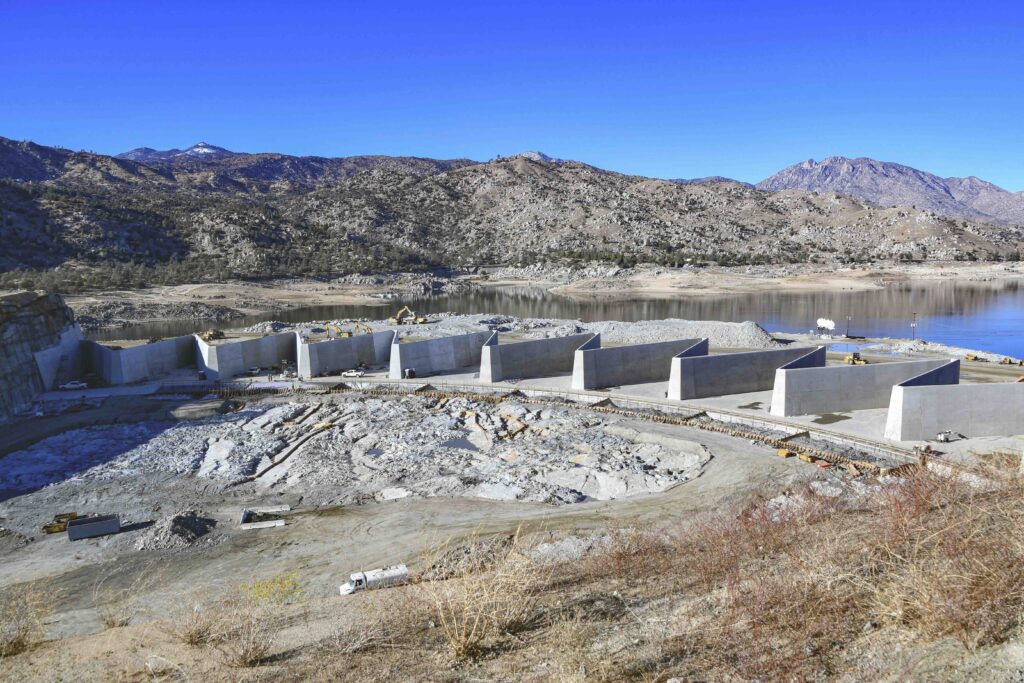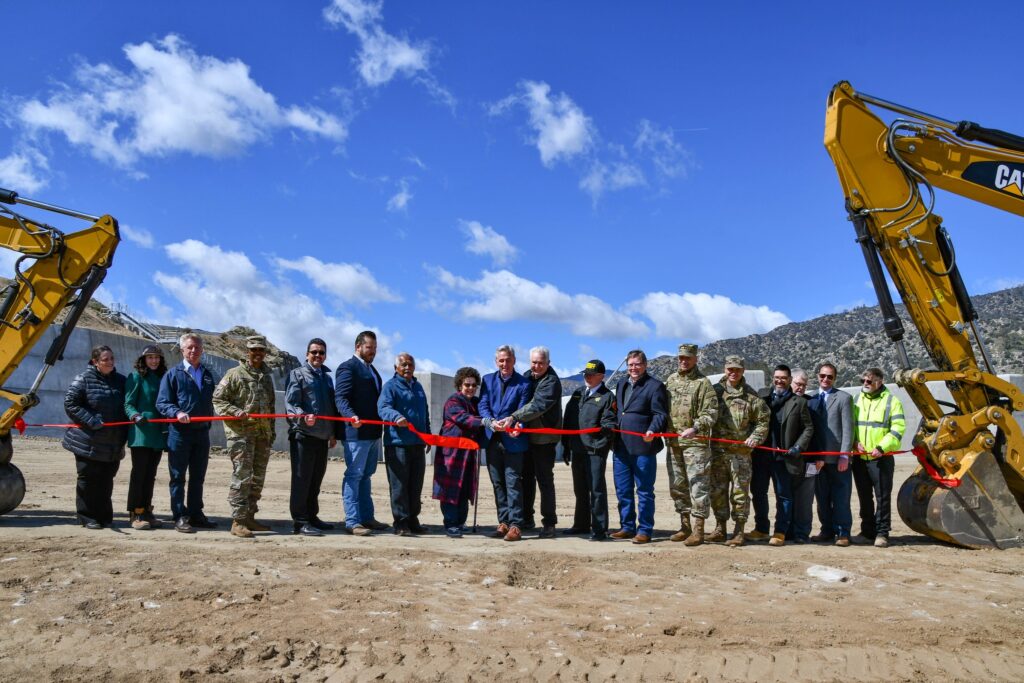
U.S. Army Corps of Engineers Sacramento District designs and constructs a labyrinth weir among a variety of additional project challenges
By Hanna Heiss
Located 40 miles northeast of Bakersfield, Kern County, California is the Isabella Reservoir. It consists of an earthfill main dam and auxiliary dam across Kern River and Hot Springs Valley.

Authorized under the Flood Control Act of 1944, dam construction commenced and was later completed in 1953, providing flood-risk management, irrigation and recreational benefits from then on.
Below the dams now are more than 300,000 people living and working in the town of Lake Isabella and the City of Bakersfield. In 2006 the U.S Army Corps of Engineers (USACE) conducted a study finding Isabella Dam to be vulnerable to overtopping, seepage and seismic damage.
In December 2012, the Record of Decision was signed and the project, led by the USACE Sacramento District, entered the pre-construction engineering and design phase.
From 2013 to 2016, the team focused on existing dam design improvements and the relocation of the U.S. Forest Service (USFS) buildings located in the excavation footprint. The Isabella Dam improvements began in late 2017 after USACE awarded a contract to the Flatiron/Dragados/Sukut Joint Venture of Benicia, California to construct the Phase II dams and spillways modifications.
The USACE Sacramento District, over the next five years, raised both the main and auxiliary dams by 16 feet, excavated a new emergency spillway, improved the dam’s filtering and drainage systems and installed the labyrinth weir.
Out of a budget of $335 million, the project construction cost to complete is approximately $330 million. Phase I, which consisted of the construction of the USFS warehouse/administrative buildings in Kernville, California and the USFS fire station in Lake Isabella, was completed in 2017. Phase II reached substantial completion in November 2022, with a ribbon-cutting ceremony held on April 4, 2023. The anticipated project completion was set for August 2023, but an update has yet to be given at the time of print.

The Complexities of the Labyrinth Weir
As always with projects of this scale, complexities are no stranger to the team. An emergency spillway had to be constructed between the main and auxiliary dams which included a new 28-foot-tall, roughly 1,300-foot-wide labyrinth weir at the top of the spillway. A very uncommon feature, the USACE Sacramento District argued that a labyrinth weir may never have been designed before.
According to the USACE Sacramento District website, a labyrinth weir is a zig-zag-patterned pseudo-dam designed to help regulate water flow through the emergency spillway rather than to hold it back like the main and auxiliary dams are designed to do.
Everything we do requires our commitment to proactive, collaborative, working relationships with partners across the public and private sectors. The Isabella Dam Safety Modification Project builds on lessons learned from other successful dam safety projects, and one of those key lessons is the value of partnership.” – Col. Chad Caldwell, Commander, U.S. Army Corps of Engineers Sacramento District
The challenge here was that the labyrinth weir required vertical rebar to support and hold at precise angles and orientations until the foundation concrete was cast. The contractor prepared steel frames bolted onto pipes cast into the leveling concrete that held the rebar to address the issue. Upon the foundation curing, the frames then could be unbolted and collapsed, allowing them to be removed from inside the rebar cage by a crane for reuse on a different section of the weir.
During the Phase II completion ribbon-cutting ceremony, USACE Commanding General Lt. Gen. Scott Spellmon, standing in front of the new labyrinth weir, exclaimed, “the amount of technical expertise on display behind me is matched only by the incredible and collaborative relationships between our partners.”

The Tales of the Spillway Challenges Continue
A shortage of rock materials also came with its own set of challenges. This lack of material required narrow areas to be opened on both sides of the emergency spillway. Additional excavation materials came from deepening the spillway floor, allowing the project to meet its material requirements.
Being able to use the rock mined from the emergency spillway excavation and processing it into embankment materials and concrete aggregates on-site helped the team towards its project goal of zero-import-export of aggregate materials. This also saved tremendous amounts of fossil fuels.
Upon completing the excavation of the emergency spillway immediately downstream of the labyrinth weir, it was found by USACE geologists that the foundation rock was much more fractured and jointed than originally expected. Addressing this, the project engineers designed a reinforced concrete “apron” that extends 25 feet downstream of the weir foundation along the entire arc of the weir.
USACE Team Delivers Project Excellence
Alongside of the pride they have taken in their extraordinary safety record, – about 2.5 million hours of labor were logged without a significant safety incident and 190 days without an OSHA

recordable safety incident – the project delivery team also took home several awards.
The team has received the honors of the USACE 2023 Project Delivery Team of the Year for Excellence award and the United States Society on Dams Excellence in Constructed Project Award, which the team was noted for high-quality construction, an incredible safety record and innovative solutions.
Hanna Heiss is the senior editor of American Infrastructure magazine.















